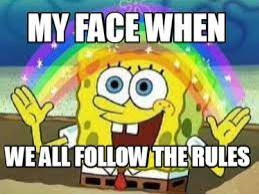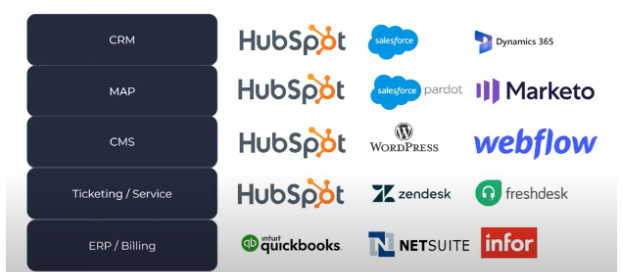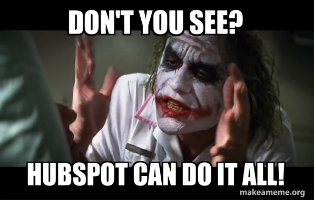Table of Contents
Having know-how is important. If a carpenter is going to build a table, it’s essential that he knows the proper steps and is able to identify the type of wood needed for the job. To actually construct the table, though, proper tools are also needed. A carpenter could have a perfect plan in place and be a master of his craft, but without tools, the table cannot be built.
Similarly, a company can have a firm grasp of their business model and corresponding GTM motions, but without the proper tools, an optimal revenue engine cannot be built. It's the RevOps tech stack that makes everything work.
If you're looking to implement a HubSpot tech stack tailored to your business goals, our HubSpot Implementations/Onboarding services can ensure everything is set up to drive efficiency.
Many companies end up overspending here. To avoid this, it can be helpful to think through the process of how a RevOps stack should be assembled.
Similarly, a company can have a firm grasp of their business model and corresponding GTM motions, but without the proper tools, an optimal revenue engine cannot be built.
It's the tech stack which makes everything work.
Watch the full video series: RevOps Summer School - with Matt Bolian
TL;DR: What a Real RevOps Tech Stack Looks Like
-
Start with core platforms like CRM, MAP, and CMS
-
Add integrated apps that feed your main systems
-
Skip standalone tools that don't talk to your stack
-
Follow four rules: adoption first, fewer databases, full integration, no misfit tools
-
HubSpot can replace 20 disconnected apps with just 5
-
Match tools to your GTM motion, from inbound to ABM to PLG
-
Consolidate your stack and run RevOps with speed and clarity
What belongs in a modern B2B tech stack and what tools should you avoid?
Many companies end up overspending here. To avoid this, it can be helpful to think through the process of how a tool stack should be assembled.
4 Essential Tool Types in Every B2B Marketing Tech Stack
Platforms
Because every company today is a tech company, you cannot survive, or even compete, in the modern business world if you do not run on a digital platform. These platforms include:
- CRM (customer relationship management)
- MAP (marketing automation platform)
- CMS (content management system)
Unless you’re running a lemonade stand, these are non-negotiables
Integrated Apps
These are apps that support the platforms above. Some examples:
- Proposals
- CPQ (configure/price/quote)
- Contact enrichments (such as ZoomInfo)
Basically, these are other platforms that integrate with your systems, but you're still touching the data in your core platforms
Stand Alone
These do not integrate with your core apps. Some examples:
- Social media scheduling
- Scheduling apps
3rd Party Services
Some examples:
- Call centers
- Someone doing outbound prospecting with the purpose of securing meetings
- An agency doing inbound
- RevOps consultant who maps out all of this information for you
MarTech Stack Rules That Make or Break Your B2B Revenue Engine
Some rules are meant to be broken. These are not those rules. When it comes to your tool stack/platforms, there are certain actions and beliefs that can cause them to either work for you or against you. Hint: you want the former.

Rule #1: Adoption is your true north. Without adoption, your process means nothing; without adoption, your tools mean nothing; without adoption, you have nothing. Adoption is the greatest good, and, to be done well, it must be thought about continuously and at all points by someone within your organization.
Rule #2: Less databases=good. Why? Because managing databases becomes exponentially more difficult as you add more.
Rule #3: No integration is not an option.
- No integration=No hypothesis, no monitoring, no measuring, no iterating, no changing
- No integration=No ability to see how conversion ratios are affected
- No integration=No RevOps
Rule #4: If it does not fit, get rid of it. When choosing a SaaS product (application), you need to consider how it will help affect and fit within your data model. This will enable you to talk about ROI. When an application can assist you in accurately predicting conversion ratios, it becomes very easy to justify spending money on it.
The Big 5 Tools You Need in a B2B Marketing Tech Stack
Every modern B2B company is going to have the following five (if you don't, you should):
CMS (Contact Management System)
- Quite simply, your website
- Platform where you manage the content on your website
- Examples: HubSpot, WordPress, Webflow
CRM Platform (Customer Relationship Management)
- Without this, you’re not doing RevOps (or you’re doing it extremely poorly)
- Excel ain't gonna cut it
- Examples: HubSpot, Salesforce, Dynamics 365, Pipedrive
MAP (Marketing Automation Platform)
- This is what HubSpot began as
- Examples: HubSpot, Salesforce Pardot, Marketo
Ticketing/Service
- A service platform to track and respond to customer issues
- This involves service portals/helpdesk and managing contracts, upsells, and renewals.
- Examples: HubSpot, Zendesk, Freshdesk
ERP (EnterPrise Resource Planning)/Billing
- Your system for revenue recognition and billing people
- Account receivables, account payables
- This is where your finance team lives and breathes
- Examples: QuickBooks, NetSuite, Infor

Why HubSpot?
An examination of the above lists and examples should make one thing glaringly obvious: HubSpot is awesome and it does a lot of stuff! Instead of, for example, using Webflow for your CMS, Salesforce for your CRM, Marketo for your MAP, and Freshdesk for your Ticketing/Service, you could just use HubSpot. Period.
As obvious as this may seem, many companies utilize the varied tool stack just described.
Pro tip: make your tool stack as uncomplicated as possible.

How should you match your B2B tech stack to your GTM strategy?
(note: not all-inclusive; only for revenue teams)
Marketing
MUST HAVES
- MAP
- CMS
INBOUND (MAY OR MAY NOT EXIST)
- Must have platform for SEO
- Must have a blog as your CMS platform
- Must have a way to make landing pages
- Must have a chat bot
- Must have webinars
PROSPECTING
- Need a tool that can do sequences
- Need a database where you can pull contacts from to make lists
- Need email validation (to prevent sending to bad email addresses and hurting email deliverability)
- Need an IP address
ABM
- Need 3rd party intent
- Need email signature (so you can change your email based on who you’re talking about and the next event you’re going to)
- Need direct mail
- Need to go to and start hosting events
TARGET
- Gifting
- Events
- Ads
Sales
MUST HAVES
- CRM
PLG
- Need product data and reverse ETL (extract, transform, load)
1 STAGE
- Need an inbound calling system
- Need CI (conversational intelligence)
2 STAGE
- Need sequences
- Need a dialer to be able to call outbound to
- Need calendar and scheduling links
- Need digital signatures
FIELD SALES
- Need CPQ and complex deal hubs
- Need ways to make proposals and customize proposals
NAMED ACCOUNTS
- Need proposals
- Need to start responding to RFPs
Customer Service
MUST HAVES
- Ticketing system (or how you’re capturing all communication/customer interaction)
COMMUNITY
- Must have a knowledge base (platform where people can “self-serve” and fix own problems/issues)
- Must have a chat feature inside and outside the application itself
HELPDESK
- Must have service portals (someone can log in and submit a ticket)
- Must have chat
- Account Management (Volume,Segment,Named)--NPS scores, CSAT, surveys
General Support
MUST HAVE
- Data quality engine
DATABASE MANAGEMENT
- Nocode automation
REPORTING
VisualizationWhy does consolidating your B2B tech stack lead to smarter RevOps and better data?
Your tool stack needs to be as integrated and cohesive as possible so that you can execute and think through your data model. This will help you do RevOps at a high level. In order to accomplish this, you need to have the least amount of tools possible. Here’s why:
- Doing RevOps well involves thinking through the ability to measure your data.
- The ability to measure your data is predicated on the data being accurate.
- The key to having accurate data is having less databases to manage (databases=tools) so that you can better apply science to the process.
For businesses aiming to integrate HubSpot with their existing tools, our HubSpot Integrations services provide seamless and strategic solutions.
What a Lean B2B Martech Stack Looks Like for a 2-Stage Revenue Team
Marketing
MAP and CMS
- Lead scoring mechanism
- A way to make social posts and a scheduler
- Website chat
- Campaign attribution (so that you can see how your marketing activities are affecting closed won revenue)
- Database enrichment (ability to create lists and enrich it)
- Phone dialer.
Sales
SEP and CRM
- CPQ mechanism
- Call recording
- A way to do digital signatures
- A way to create proposals
- Ability to track commissions (Shout out to QuotaPath!)
- Calendar service for meetings
Customer Service
TICKETING/BILLING/ERP SYSTEMS
- Surveys
- Contract management system
- Way to look at renewals/upsells/crossells
Again, this is a basic tool stack for a modern B2B 2-Stage company (revenue team ONLY). It is comprised of 20 apps. 20. 20!
For a majority of companies, these are almost all individual, different tools. It doesn’t have to be this way (nor should it be this way).
How can you simplify your B2B tech stack without losing functionality or performance?
App integration is the name of the game. Put all of the following on the SAME platform:
- MAP
- CMS
- SEP
- CRM
- Ticketing/service
- Surveys
- Phone dialer
- CPQ
- Contract management
- Campaign attribution
- Call recording
- Renewal/upsell/cross sell management (customer retention)
- Social
- Website chat
- Digital signature
- Lead scoring
- Calendar service
Our HubSpot Technical Consulting services can guide you in building a RevOps stack with fewer apps and better efficiency, reducing complexity across your operations.
All of the above tools can be accessed via HubSpot, reducing your apps down to 5 from the original 20. That’s the magic of HubSpot.
That's how you do RevOps implementation better than your competitors.
If you're migrating from another system or consolidating tools, our HubSpot Migrations services ensure a smooth transition to HubSpot with minimal disruption.
Speaking of “HubSpot” and “doing RevOps better than your competitors”, at RevPartners we offer RevOps as a service.

We can help you consolidate your tech stack and streamline efficiency. Just like a carpenter needs the right tools for the job, you need the right RevOps team…us!
The Revenue Performance Model
Do you want to track the entire revenue journey in your CRM so you can see what's broken, why it happened, and where to fix it?
Download the Revenue Performance Model HERE



-3.png)
-3.png)
-1.png)
